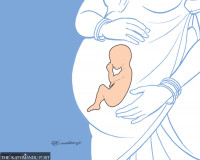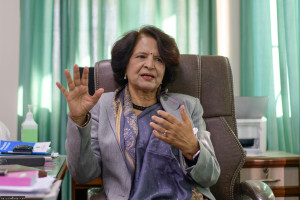Health
Take period pains seriously. It could be endometriosis
The condition involves severe pelvic pain, heavy bleeding during periods, and could cause infertility if not treated.
Manushree Mahat
Nineteen-year-old Ekta suffers from excruciating pain during her periods. It is far beyond the usual pain and cannot be managed with medication–she’s tried that multiple times. Taking one dose of Meftal (a period pain medication) is never enough. The pain is debilitating most of the time.
Despite several visits to gynaecologists, her complaints have been brushed aside as normal period pains. She strongly feels that her pain is abnormal, but feels powerless to address her issues.
“The pain is so bad, but I cannot do anything about it,” she says. “I can’t count the number of times that I’ve been told that my debilitating pain is normal,” bemoans Ekta, whose name has been changed to protect her privacy.
The normalisation of period pains means serious reproductive conditions like endometriosis often go untreated. People with endometriosis experience severe pelvic pain because tissues like that found outside the uterus grow inside it. Other symptoms of the condition include heavy bleeding during and between periods and fatigue. There is no known cure for this condition, and symptoms can start from the first period onwards.
A major challenge experienced by women with endometriosis is the disregard of their symptoms by the public and medical professionals alike. Due to lack of awareness about the debilitating pain typical to endometriosis, both the person suffering from the condition, and their doctors often underestimate their severity.
Severe pelvic pain is a key indicator for diagnosing endometriosis, says Dr Reena Shrestha, a gynaecologist at Madhyapur Hospital. When patients seek consultation regarding the kind of severe pain that significantly disrupts their lives, they may undergo two types of tests: transvaginal ultrasound and diagnostic laparoscopy. These procedures are used to determine the presence of endometriosis.
Endometriosis is a complex condition, says Dr Hema Pradhan, a consultant gynaecologist at Everest Hospital. Amongst all the patients she meets at her consultations, many frequently turn out to have endometriosis. But, she’s noticed that often patients often delay seeking treatment because period pains are often normalised.
“Women who come to me with their symptoms often delay seeking treatment, because, regardless of the severity of their pain, they believe all period pains to be normal,” says Pradhan.
Eighteen-year-old Rima (name change) has been struggling with excessive pain before and during periods for years. She also experiences pain while urinating during her periods. Rima has also been diagnosed with Polycystic Ovarian Syndrome (PCOS). The co-occurence of PCOS and endometriosis is not unheard of, although research on them has been minimal.
“I can barely walk when I’m on my periods, but I’ve always been told that I should just learn to live with it,” she says.
Despite knowing about PCOS, she discovered the possibility of having endometriosis quite later in life. She shares this because period pain, even excessive ones, have been normalised for far too long.
The general lack of awareness of endometriosis, and widespread normalisation of period pains, often results in late diagnosis and treatment of the condition.
Although there may be no cure to the condition, there are ways to manage its most severe symptoms. Furthermore, receiving a diagnosis can greatly help patients to understand the severity of their condition, according to doctors.
“I’m incapable of doing anything during my periods. One time I had to leave the examination in the middle of my exams because of the pain,” says Ekta. “I can’t study, can’t work, all I can do is stay in bed and cry,” she adds.
Dr Pradhan reveals another challenging aspect of diagnosing endometriosis. Sometimes the condition may not appear on ultrasound scans initially. Endometrial deposits may appear differently in women due to hormonal changes. Furthermore, symptoms may vary, with some being asymptomatic altogether.
According to Dr Shrestha, once a gynaecologist confirms that the patient has endometriosis, they will certainly recommend methods to manage the pain. These include analgesics for pain relief, and home remedies like hot water bag massage.
However, the main problem remains. Due to lack of awareness, most patients may only find out about their condition later in life.
In some cases women only discover they have endometriosis when they face infertility. Endometriosis is associated with infertility, and 30-50% of people with endometriosis may experience infertility.
This also exposes another troubling aspect associated with endometriosis. Ekta shares that her relatives often express concerns about her potential infertility.
“They just make me feel bad that I might never get pregnant. And it makes me feel worse,” Ekta adds.
Worldwide, endometriosis has been known as a scientifically under-researched condition. It has even been called the ‘missed disease’ because of inconsistencies in its diagnosis and treatment. Endometriosis has also been widely ignored by policy makers.
Treatment for endometriosis depends on the individual, says Dr Pradhan. Some are treated with hormonal medication, and others require surgical procedures. The main way to combat endometriosis is timely diagnosis, and timely treatment, she adds.
“Raising awareness, timely diagnosis, and treatment are very important,” Dr Pradhan says.




 5.62°C Kathmandu
5.62°C Kathmandu














